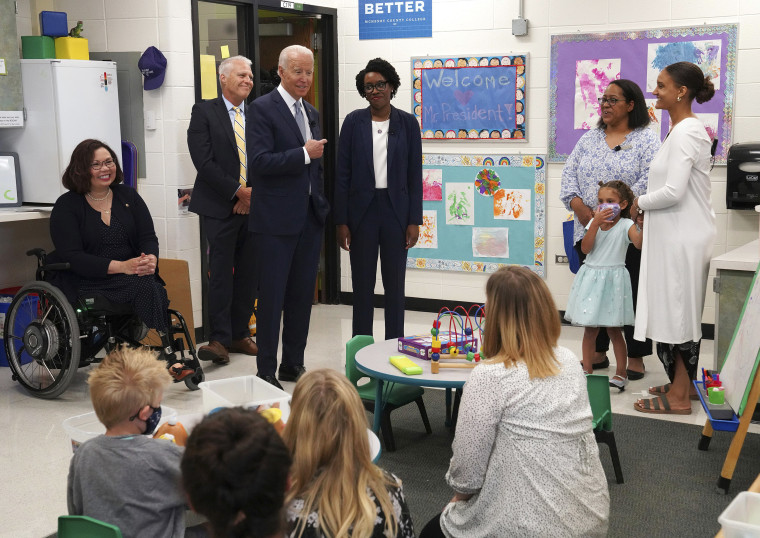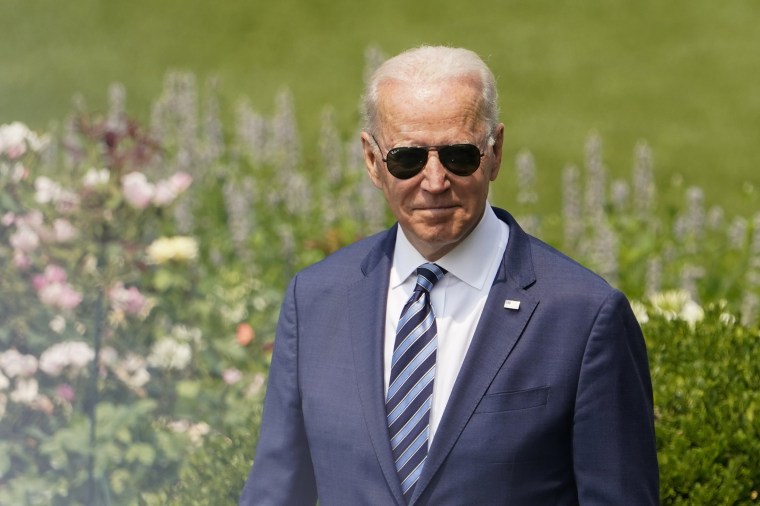WASHINGTON — When Rep. Lauren Underwood's first congressional campaign was looking for a shot of momentum in the closing days of her uphill race in 2018, Joe Biden was one of the few brand-name Democrats who showed up, rallying more than 1,000 voters in the exurbs of Chicago.
And so as Underwood’s team began planning for what will likely be an unpredictable 2022 re-election bid, they put in an early request to the House Democrats’ campaign arm to have the president campaign with her again this year — only to find out the White House already had eyed her district in Illinois as a natural fit to promote his plan to dramatically expand the social safety net.
When he arrived in a Republican-leaning part of her swing district this month to push his spending plan, he also made sure to embrace her at the same time, praising Underwood’s leadership on a key issue for her: maternal mortality. His comments will now become part of her television advertising.
“We’re cutting that into a spot,” said Ronnie Cho, a senior Underwood adviser and her 2018 campaign manager.
The 2022 midterm elections are still more than 16 months away. But Biden's visit to the district this month offered a glimpse at the Biden White House's plan to try to protect the razor-thin Democratic majorities in the House and Senate, even as it works to implement the president's agenda now.

The White House’s midterm strategy appears simple: enact policies that deliver a tangible benefit to ordinary Americans’ lives, and travel the country to make sure voters know it. But while the president has already secured a $1.9 trillion bill that includes $1,400 payments and cash to raise children, success will ultimately hinge on passage of Biden’s $4 trillion infrastructure and economic plans, which remain in flux on Capitol Hill. The historical trends, meanwhile, are daunting.
The party of the incumbent president, with rare exceptions, typically loses ground in midterm races. In 2018, then-President Donald Trump saw a 40-seat swing in the House that put Democrats in power there for the first time since 2011, when it was then-President Barack Obama’s Democrats who suffered an electoral shellacking by the GOP.
Biden advisers and their Democratic partners hope to buck that trend, aided by the fact that the president still enjoys favorable approval ratings and his economic proposals are broadly popular. And for now, at least, Democrats further down the ballot see a stronger partnership than was the case under Obama, exemplified by those like Underwood who are welcoming Biden to their turf.
With plans for an active travel schedule to promote policy proposals tailored to the middle-class voters Biden has long considered his base, the administration is laying the groundwork to continue to help vulnerable Democrats make a case for extending one-party control of Washington with the mantra that “good governance equals good policy, and good politics,” as Emmy Ruiz, the White House director of political strategy, put it to NBC News in an interview.
“The last time the Democrats had a good off-year election with a new president was 1934 under Franklin Delano Roosevelt,” said Brad Miller, a former Democratic congressman who represented North Carolina from 2003 to 2013. “And that's because people looked at the New Deal and said: ‘Yes! This is what we want you to do! Do more of this!’”
Miller said that while a 1934-style election is unlikely, Biden is wise to take a page from Roosevelt and call for trillions of dollars in economic safety net spending and tax hikes on the rich: “If they are seen as having responded to a pretty significant crisis in the economy, then that will help a great deal.”
That’s what Biden’s team has in mind, even as Republicans are telegraphing unified opposition to a $3.5 trillion package, complaining of runaway spending and arguing that it would exacerbate inflation.
When Democrats secured an expansion of the child tax credit as part of their $1.9 trillion Covid relief bill, Gene Sperling, the man Biden tasked with overseeing its implementation, said he held meetings three times a week with IRS officials to ensure that credit could be paid directly to beneficiaries monthly, rather than as an end-of-year deduction.
The White House in turn launched a campaign-style blitz last week promoting the $250 or $300 per child direct deposits as they began hitting bank accounts July 15.
“These are changes that are improving people’s lives. And if that’s what we’re talking about in a year and three months, I think we welcome that conversation,” Ruiz said.
That tour, and others, have often dovetailed with midterm battlegrounds.
The president, vice president and other top administration officials have crisscrossed the country this year to promote other benefits of Biden’s rescue plan, including a stop by Biden in Georgia, the state that helped put him in the White House and gave Democrats control of the Senate.
To sell his infrastructure agenda, Biden traveled more recently to Underwood’s district — one that Trump won in 2016 and only narrowly lost to Biden four years later — and to another in Wisconsin that is one of just seven in the country that Trump carried but is represented by a Democrat in the House.
On Wednesday, Biden will visit a union training facility in Cincinnati, Ohio, a state with a key Senate race in 2022, and just across the river from another represented by Sen. Mitch McConnell, the Republican Senate leader from Kentucky.
On Friday, Biden will hold his first public campaign rally since taking office, making a short trip to Virginia in support of the state's Democratic candidate for governor, Terry McAuliffe, who is seeking to return to the Statehouse in November in a state where governors cannot run for re-election.
“We have built some great alliances and some great partnerships with swing state governors, with mayors. So of course those are all considerations,” Ruiz said when asked about the president’s politically tinged travel. “But our No. 1 consideration is taking this story and taking this message to the American people. We have to be smart about it, and we are.”
“This is a little taste of how much you can expect that he’s going to have Democrats’ back,” she added.
In 2010, vulnerable Democrats largely kept Obama at arm’s length as Republicans campaigned against the Affordable Care Act and debt and deficits. And four years later, it was again more often Biden paying a visit to battleground races — he held more than 114 events for 66 different Democratic candidates, committees and parties.
It’s a marked contrast owing to a very different political landscape. A political realignment has left Democrats stronger in the suburbs and less dependent on culturally conservative rural areas. There are far fewer voters likely to “split” their tickets between candidates of different parties. And many Democrats, after trying and failing in the Obama era, have discovered that running from the president doesn’t help.
But there is a racial component as well, according to Democratic strategists. Biden, an older white man, doesn’t generate the racial backlash that the first Black president did.
Biden “doesn’t seem scary culturally” to voters in competitive districts, Miller said, adding: “He's not culturally threatening. Obama was. There was just a big mess of cultural discomfort around Obama.”
Cornell Belcher, a former Obama pollster, said he was struck watching a group of Republicans last month join Biden for a chummy news conference at the White House to discuss a bipartisan infrastructure deal they had just struck.
“They never wanted photo ops with Barack Obama. They never wanted to be seen as trying to work with Barack Obama to accomplish anything,” Belcher said.
Jaime Harrison, chairman of the Democratic National Committee, did not mince words in describing how the party is working to avoid a repeat of the Obama midterm drubbings.
“After the 2008 race we abandoned the 50-state strategy,” Harrison said. “We stopped sending resources to state parties to build their operations, to make sure that we have the organizers on the ground. We didn't do voter registration. So states were fending for themselves almost. That's not the case anymore.”
Since the start of the year, the DNC has announced commitments of $25 million for a voter protection campaign aimed at counteracting recent GOP-backed election law changes, $23 million to invest in state parties, and $20 million directly targeting the midterm elections.
“All of that would not have happened without the blessing of Joe Biden,” he said. “This guy believes in the party. He believes in the DNC. He believes in the grassroots. And so I would expect him going all over this country on behalf of Democrats in the midterms, to having the vice president go all over this country on behalf of Democrats in the midterms.”
Biden advisers note that the longtime senator has always been engaged in congressional and off-year races. In 2018, Biden visited 24 states for events with 65 candidates, including 18 public rallies after Labor Day — like the late stop with Underwood — that also served as an early test run for his 2020 presidential campaign message.
Alex Conant, a veteran Republican strategist, said Democrats shouldn’t get too comfortable with Biden’s popularity at this stage.
“I think Obama was still really popular at this point in his presidency,” he said in an email, noting that the former Democratic president’s approval ratings tumbled closer to the 2010 election. “That could still happen to Biden, in which case they'll likely have similar midterm experiences.”


